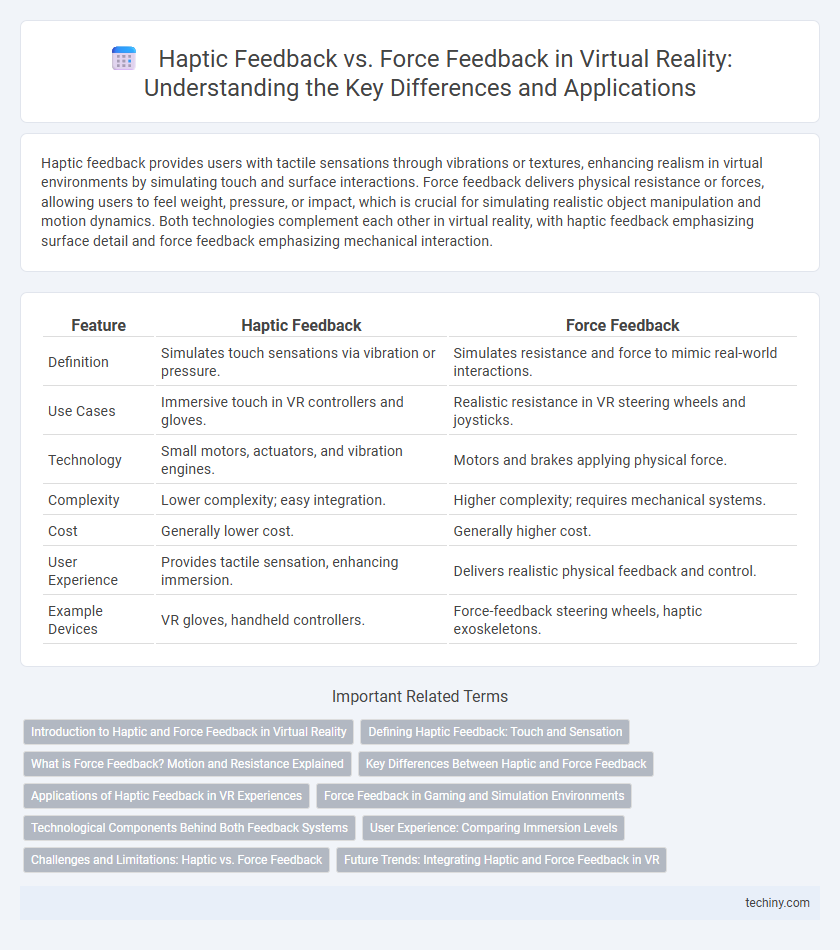Haptic feedback provides users with tactile sensations through vibrations or textures, enhancing realism in virtual environments by simulating touch and surface interactions. Force feedback delivers physical resistance or forces, allowing users to feel weight, pressure, or impact, which is crucial for simulating realistic object manipulation and motion dynamics. Both technologies complement each other in virtual reality, with haptic feedback emphasizing surface detail and force feedback emphasizing mechanical interaction.
Table of Comparison
| Feature | Haptic Feedback | Force Feedback |
|---|---|---|
| Definition | Simulates touch sensations via vibration or pressure. | Simulates resistance and force to mimic real-world interactions. |
| Use Cases | Immersive touch in VR controllers and gloves. | Realistic resistance in VR steering wheels and joysticks. |
| Technology | Small motors, actuators, and vibration engines. | Motors and brakes applying physical force. |
| Complexity | Lower complexity; easy integration. | Higher complexity; requires mechanical systems. |
| Cost | Generally lower cost. | Generally higher cost. |
| User Experience | Provides tactile sensation, enhancing immersion. | Delivers realistic physical feedback and control. |
| Example Devices | VR gloves, handheld controllers. | Force-feedback steering wheels, haptic exoskeletons. |
Introduction to Haptic and Force Feedback in Virtual Reality
Haptic feedback in virtual reality provides tactile sensations by stimulating the skin, enabling users to perceive textures, vibrations, and surface interactions. Force feedback goes deeper by replicating resistance and physical forces, simulating the weight, inertia, and impact of virtual objects for a more immersive experience. Both technologies enhance user immersion, with haptic feedback focusing on touch sensations and force feedback delivering realistic physical interactions in VR environments.
Defining Haptic Feedback: Touch and Sensation
Haptic feedback in virtual reality primarily involves tactile sensations that simulate the sense of touch, enhancing user immersion through vibrations, textures, and surface variations delivered via wearable devices or controllers. Unlike force feedback, which replicates resistance and physical forces to simulate real-world interactions, haptic feedback focuses on the nuanced perception of touch and texture changes. This technology enables realistic sensory experiences by translating virtual interactions into physical sensations that the user can feel on their skin.
What is Force Feedback? Motion and Resistance Explained
Force feedback in virtual reality refers to technology that delivers physical sensations by applying controlled resistance and motion to the user's movements, simulating real-world forces. Unlike basic haptic feedback that provides simple vibrations, force feedback replicates dynamic forces such as push, pull, and torque, enhancing immersion through realistic interaction with virtual objects. This technology is crucial in applications like VR training simulators and gaming glove systems, where accurate force replication improves user experience and skill development.
Key Differences Between Haptic and Force Feedback
Haptic feedback refers to the broad sense of tactile sensations provided to the user, including vibrations, textures, and subtle touch cues, enhancing immersion in virtual reality. Force feedback specifically involves applying physical resistance or forces that simulate the weight, inertia, or impact of virtual objects, enabling realistic interaction with VR environments. The key difference lies in haptic feedback delivering sensory stimulation to the skin, while force feedback actively resists or moves limbs or controllers to mimic real-world physical forces.
Applications of Haptic Feedback in VR Experiences
Haptic feedback in VR enhances user immersion by simulating tactile sensations such as texture, vibration, and temperature, enabling realistic interactions with virtual objects. Applications include medical training simulators for surgery practice, gaming environments that replicate physical impacts, and remote robotic control where users receive precise touch feedback. This technology improves spatial awareness and emotional engagement, making virtual experiences more intuitive and lifelike.
Force Feedback in Gaming and Simulation Environments
Force feedback in gaming and simulation environments enhances user immersion by replicating real-world physical sensations through resistance and pressure applied to controllers or equipment. This technology allows players to experience realistic interactions, such as the recoil of a gun or the tension of steering a vehicle, improving precision and engagement. Force feedback systems, integral to flight simulators and racing games, provide critical tactile cues that contribute to skill development and situational awareness.
Technological Components Behind Both Feedback Systems
Haptic feedback relies on vibration motors and actuators embedded in gloves or wearable devices to simulate touch sensations, providing tactile information to users. Force feedback incorporates motors, gears, and linkages in devices such as joysticks or exoskeletons to generate resistance and physical forces, enabling users to feel weight and tension in virtual environments. Both systems utilize sensors and microcontrollers to interpret user movements and adjust feedback dynamically, enhancing immersion in virtual reality experiences.
User Experience: Comparing Immersion Levels
Haptic feedback in virtual reality uses vibrations and tactile sensations to simulate textures and surface details, enhancing fine touch interaction and realism. Force feedback applies resistance or pressure forces through devices like gloves or joysticks, providing a stronger sensation of physical interaction with virtual objects. Users typically experience higher immersion levels with force feedback due to its ability to replicate actual physical constraints, though haptic feedback improves detailed tactile engagement.
Challenges and Limitations: Haptic vs. Force Feedback
Haptic feedback technology faces challenges in delivering precise tactile sensations due to limited resolution and latency issues, which can affect user immersion in virtual reality environments. Force feedback systems struggle with accurately simulating complex forces and often require bulky hardware, limiting portability and long-term use. Both technologies encounter limitations in replicating natural touch sensations, necessitating ongoing advancements in sensor design and material science for improved realism.
Future Trends: Integrating Haptic and Force Feedback in VR
Future trends in virtual reality emphasize the seamless integration of haptic feedback and force feedback to create more immersive and realistic experiences. Advanced materials and actuators are being developed to enhance tactile sensations, while AI-driven adaptive systems tailor feedback in real time. This convergence is expected to revolutionize VR applications in gaming, training simulations, and remote robotic control by providing nuanced physical interactions.
Haptic feedback vs Force feedback Infographic

 techiny.com
techiny.com